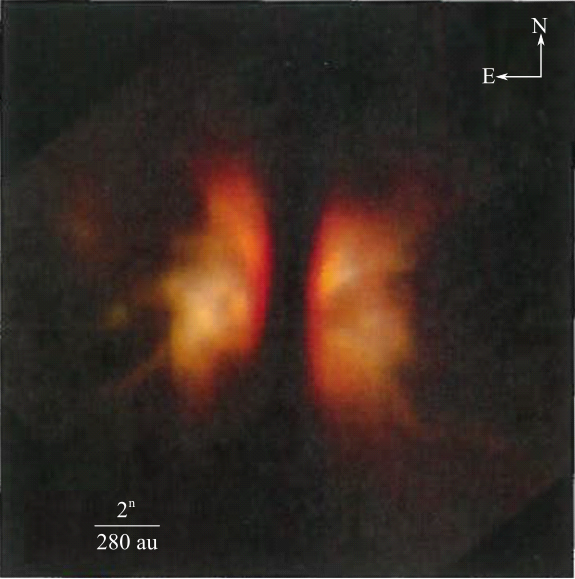
(a)
The diameter of the disk as shown in the figure below using the scale bar provided below it.

(a)
Answer to Problem 20Q
Solution:
The diameter is, approximately,
Explanation of Solution
This can be calculated directly by calibrating our usual scale with the scale bar provided below the figure and measuring the diameter of the disk. This diameter comes to be around
Conclusion:
Hence, the diameter of the disk is
(b)
The volume of the disk if its thickness is
(b)
Answer to Problem 20Q
Solution:
Volume of the disk is
Explanation of Solution
Given data:
The thickness of the disk is
Formula used:
The expression for volume of the disk is written as,
Here,
Use the conversion formula,
Explanation:
The expression for the radius of the disk (r) is written as,
Here, d is the diameter of disk.
Substitute
Recall the expression for the volume of the disk.
Substitute
Conclusion:
Thus, the volume of the disk is
(c)
The number of hydrogen atoms and hydrogen atoms per cubic meter of the disk if the total mass of the disk is
(c)
Answer to Problem 20Q
Solution:
The total number of hydrogen atoms in the disk is
Explanation of Solution
Given data:
The thickness of the disk is
Formula used:
The expression for the total number of hydrogen atoms
Here,
Explanation:
If the total mass of the disk and the mass of each hydrogen atom are given, provided that the disk is composed entirely of hydrogen atoms, the number of hydrogen atoms is:
Substitute
Conclusion:
Thus, the total number of hydrogen atoms in the entire disk is
(d)
The number of hydrogen atoms per cubic meter of the disk. Also compare it with the density of air, which contains about
(d)
Answer to Problem 20Q
Solution:
Number of hydrogen atoms per cubic meter is
Explanation of Solution
Given data:
The thickness of the disk is
Formula used:
The number of atoms per cubic meter
Here,
Explanation:
From part (c), total number of hydrogen atoms in the disk (N) is
From part (b), volume of the disk is
Recall the expression for number of atoms per cubic meter
Substitute
Thus, the disk has a density much less than that of the air we breathe, which is
Conclusion:
Thus, the number of hydrogen atoms per cubic meter is
Want to see more full solutions like this?
Chapter 8 Solutions
Universe
- For number 11 please sketch the harmonic on graphing paper.arrow_forward# E 94 20 13. Time a) What is the frequency of the above wave? b) What is the period? c) Highlight the second cycle d) Sketch the sine wave of the second harmonic of this wave % 7 & 5 6 7 8 * ∞ Y U 9 0 0 P 150arrow_forwardShow work using graphing paperarrow_forward
- Can someone help me answer this physics 2 questions. Thank you.arrow_forwardFour capacitors are connected as shown in the figure below. (Let C = 12.0 μF.) a C 3.00 με Hh. 6.00 με 20.0 με HE (a) Find the equivalent capacitance between points a and b. 5.92 HF (b) Calculate the charge on each capacitor, taking AV ab = 16.0 V. 20.0 uF capacitor 94.7 6.00 uF capacitor 67.6 32.14 3.00 µF capacitor capacitor C ☑ με με The 3 µF and 12.0 uF capacitors are in series and that combination is in parallel with the 6 μF capacitor. What quantity is the same for capacitors in parallel? μC 32.14 ☑ You are correct that the charge on this capacitor will be the same as the charge on the 3 μF capacitor. μCarrow_forwardIn the pivot assignment, we observed waves moving on a string stretched by hanging weights. We noticed that certain frequencies produced standing waves. One such situation is shown below: 0 ст Direct Measurement ©2015 Peter Bohacek I. 20 0 cm 10 20 30 40 50 60 70 80 90 100 Which Harmonic is this? Do NOT include units! What is the wavelength of this wave in cm with only no decimal places? If the speed of this wave is 2500 cm/s, what is the frequency of this harmonic (in Hz, with NO decimal places)?arrow_forward
- Four capacitors are connected as shown in the figure below. (Let C = 12.0 µF.) A circuit consists of four capacitors. It begins at point a before the wire splits in two directions. On the upper split, there is a capacitor C followed by a 3.00 µF capacitor. On the lower split, there is a 6.00 µF capacitor. The two splits reconnect and are followed by a 20.0 µF capacitor, which is then followed by point b. (a) Find the equivalent capacitance between points a and b. µF(b) Calculate the charge on each capacitor, taking ΔVab = 16.0 V. 20.0 µF capacitor µC 6.00 µF capacitor µC 3.00 µF capacitor µC capacitor C µCarrow_forwardTwo conductors having net charges of +14.0 µC and -14.0 µC have a potential difference of 14.0 V between them. (a) Determine the capacitance of the system. F (b) What is the potential difference between the two conductors if the charges on each are increased to +196.0 µC and -196.0 µC? Varrow_forwardPlease see the attached image and answer the set of questions with proof.arrow_forward
- How, Please type the whole transcript correctly using comma and periods as needed. I have uploaded the picture of a video on YouTube. Thanks,arrow_forwardA spectra is a graph that has amplitude on the Y-axis and frequency on the X-axis. A harmonic spectra simply draws a vertical line at each frequency that a harmonic would be produced. The height of the line indicates the amplitude at which that harmonic would be produced. If the Fo of a sound is 125 Hz, please sketch a spectra (amplitude on the Y axis, frequency on the X axis) of the harmonic series up to the 4th harmonic. Include actual values on Y and X axis.arrow_forwardSketch a sign wave depicting 3 seconds of wave activity for a 5 Hz tone.arrow_forward
 Horizons: Exploring the Universe (MindTap Course ...PhysicsISBN:9781305960961Author:Michael A. Seeds, Dana BackmanPublisher:Cengage Learning
Horizons: Exploring the Universe (MindTap Course ...PhysicsISBN:9781305960961Author:Michael A. Seeds, Dana BackmanPublisher:Cengage Learning Foundations of Astronomy (MindTap Course List)PhysicsISBN:9781337399920Author:Michael A. Seeds, Dana BackmanPublisher:Cengage Learning
Foundations of Astronomy (MindTap Course List)PhysicsISBN:9781337399920Author:Michael A. Seeds, Dana BackmanPublisher:Cengage Learning Stars and Galaxies (MindTap Course List)PhysicsISBN:9781337399944Author:Michael A. SeedsPublisher:Cengage Learning
Stars and Galaxies (MindTap Course List)PhysicsISBN:9781337399944Author:Michael A. SeedsPublisher:Cengage Learning
 AstronomyPhysicsISBN:9781938168284Author:Andrew Fraknoi; David Morrison; Sidney C. WolffPublisher:OpenStax
AstronomyPhysicsISBN:9781938168284Author:Andrew Fraknoi; David Morrison; Sidney C. WolffPublisher:OpenStax Stars and GalaxiesPhysicsISBN:9781305120785Author:Michael A. Seeds, Dana BackmanPublisher:Cengage Learning
Stars and GalaxiesPhysicsISBN:9781305120785Author:Michael A. Seeds, Dana BackmanPublisher:Cengage Learning





